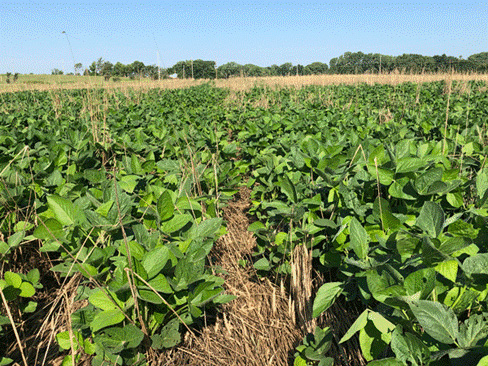Incorporating cereal rye after corn, in a corn soybean rotation, can be a valuable management tool to scavenge residual nitrogen (N), reduce soil erosion and evaporation, and suppress weeds. Cereal rye can be part of an effective weed management program in soybean production. The growing cover crop competes with weeds that emerge early in the spring, and residue from the terminated cereal rye can suppress weed growth (see companion eUpdate article about fall-emerged marestail). Cereal rye roots scavenge residual nitrogen in the soil profile, reducing N leaching and anchoring soil in place, reducing erosion. Cereal rye residue can also protect the soil surface from erosion caused by rain and runoff water, as well as reduce evaporation from the soil during the growing season (Figure 1).
A publication from K-State and the Midwest Cover Crop Council, “Post Corn, Going to Soybean: Use Cereal Rye”, provides helpful information for producers looking to incorporate a cereal rye cover crop following corn harvest. This fact sheet is an excellent resource for farmers who are new to cover crops. This publication covers various topics, which are summarized in this article. The complete factsheet can be viewed at: https://bookstore.ksre.ksu.edu/pubs/MF3504.pdf.

Figure 1. Residue from a terminated cereal rye cover crop helps manage weeds throughout the growing season. Photo by DeAnn Presley, K-State Research and Extension.
Planning and Preparation
- Residual corn herbicides—Fall-seeded cereal rye can be established successfully following the application of most herbicides used in corn production, but success is influenced by herbicide rate and environmental conditions that follow the herbicide application. If cereal rye will be grazed or fed to livestock, there are some restrictions. See the USDA-NRCS Cover Crop Termination Guidelines, or consult your agricultural chemical supplier or agronomist for potential carryover herbicide concerns, and always read and follow the instructions on the herbicide label.
- Seed purchase—Order cereal rye seed early. Named varieties can produce substantially more growth or more predictable growth and maturity, but are more expensive than VNS
(variety not stated) seed. Choose seed (named variety or VNS) that has been cleaned (free of weed seeds and other contaminants), tested for germination, and has a seed tag, even if it is VNS.
Fall Work
- Corn harvest—Harvest the crop as early as possible in fields to be planted to cereal rye.
- Tillage or no-tillage—To allow for adequate cover crop growth, it is best or easier if no full-width tillage is planned for after rye planting or before the intended rye termination date. Thus, it is easier to integrate cover crops into no-till or strip-till systems.
- Timing of planting—For maximum biomass, plant cereal rye as soon after corn harvest as possible. However, cereal rye poses a moderately high risk as a host for wheat streak mosaic virus and wheat curl mites, which means it will pose a risk to neighboring wheat crops if it emerges before wheat does. Use the Cover Crop Selector Tool (in Resources) to find planting dates for your county. For most of Kansas, plant no later than November 1.
- Seeding rate—The recommended drilled seeding rate is 55 to 60 pounds per acre; if seeded with an airplane, the rates should be 1.5 times the drilled rate (required if participating in USDA-NRCS programs). These rates are based on high-quality seed with germination rates of 85 to 98%. Increase rates with later plantings.
- Planting method—Drill seed 0.75 to 1.50 inches deep or broadcast with shallow incorporation.
Additional resources
Cover Crop Selector Tool – https://covercroptool.midwestcovercrops.org/ , available from Midwest Cover Crops Council, https://www.midwestcovercrops.org/
USDA-NRCS Cover Crop Termination Guidelines – https://www.rma.usda.gov/en/Topics/Cover-Crops
DeAnn Presley, Soil Management Specialist
deann@ksu.edu
Sarah Lancaster, Extension Weed Science Specialist,
slancaster@ksu.edu
Peter Tomlinson, Environmental Quality Specialist,
ptomlin@ksu.edu
Tags: cover crops cereal rye